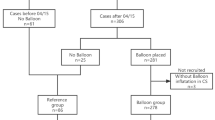Abstract
Introduction
Consecutive intra-umbilical vein injection of misoprostol and intravenous sulprostone in the management of retained placenta (RP).
Purpose
The general accepted treatment of RP is manual removal of the placenta (MRP), but medical intervention protocols were suggested. We evaluate a protocol of using intra-umbilical vein injection of misoprostol followed, if necessary, by intravenous sulprostone. A reduction in the need for MRP and less blood loss was expected.
Methods
Cohort A (1 January 2007 to 31 September 2008), managed by an expectative protocol including active management of the third stage of labor and if necessary MRP performed 60 min after birth of the baby, was compared with cohort B (1 April 2009 to 31 December 2010) managed by medical intervention protocol. This protocol consisted of intra-umbilical vein injection of misoprostol and if not successful, 250 μg of sulprostone was given intravenously in 30 min. All vaginal deliveries after 24 weeks of gestation, with RP after 20 min and blood loss <500 mL were included. An intention to treat analysis was performed, with the need for MRP as the primary outcome.
Results
Baseline characteristics were similar. In cohort A, 275 women met the inclusion criteria and 57 (20.7 %) women needed MRP. In cohort B, 219 women were included and 35 (16 %) women needed MRP. There was no significant difference in number of MRP, the amount of blood loss and other secondary outcomes.
Conclusions
We conclude that the use of intra-umbilical vein injection of misoprostol and intravenous sulprostone consecutively, does not reduce the number of MRPs as well as the total amount of blood loss in women with RP after 20 min. The study shows that changing obstetric management by extrapolating results from specific study groups to a general population may lead to other results.

Similar content being viewed by others
References
Carroli G, Bergel E (2001) Umbilical vein injection for management of retained placenta. Cochrane Database Syst Rev 4:CD001337
Van Beekhuizen HJ, de Groot AN, De Boo T, Burger D, Jansen N, Lotgering FK (2006) Sulprostone reduces the need for the manual removal of the placenta in patients with retained placenta: a randomized controlled trial. Am J Obstet Gynecol 194(2):446–450
Bais JM, Eskes M, Pel M, Bonsel GJ, Bleker OP (2004) Postpartum haemorrhage in nulliparous women: incidence and risk factors in low and high risk women. A Dutch population-based cohort study on standard (≥500 ml) and severe (≥1,000 ml) post-partum haemorrhage. Eur J Obstet Gynecol Reprod Biol 115(2):166–172
Weeks Andrew D (2008) The retained placenta. Best Pract Res Clin Obstet Gynaecol 22(6):1103–1117
Rogers MS, Yeun PM, Wong S (2007) Avoiding manual removal of placenta: evaluation of intra-umbilical injection of uterotonics using Pipingas technique for management of adherent placenta. Acta Obstet Gynecol Scand 86(1):48–54
World Health Organization (2009) WHO guidelines for the management of postpartum haemorrhage and retained placenta. ISBN 978 92 4 159851 4
Hagenaars M, Knape JT, Backus EM (2011) Pulmonary oedema after high infusion rate of sulprostone. URL: http://bja.oxfordjournals.org. Accessed on 25 Apr 2011
Chen FG, Koh KF, Chong YS (1998) Cardiac arrest associated with sulprostone use during caesarean section. Anaesth Intensive Care 26(3):298–301
Stefanovic V, Paavonen J, Loukovaara M, Halmesmäki E, Ahonen J, Tikkanen M (2013) Intravenous sulprostone infusion in the treatment of retained placenta. Acta Obstet Gynecol Scand 92(4):426–432
Nardin JM, Weeks A, Carroli G (2011) Umbilical vein injection for management of retained placenta. Cochrane Database Syst Rev Issue 5, CD001337. doi: 10.1002/14651858.CD001337
Harara R, Hanafy S, Saad Alsayed Zidan M, Alberry M (2011) Intraumbilical injection of three different uterotonics in the management of retained placenta. J Obst Gynaecol Res 37(9):1203–1207
Conflict of interest
None of the authors have a conflict of interest.
Author information
Authors and Affiliations
Corresponding author
Rights and permissions
About this article
Cite this article
Notten, F., Meertens, L., Wissink, B. et al. Consecutive intra-umbilical vein injection of misoprostol and intravenous sulprostone in the management of retained placenta. Arch Gynecol Obstet 289, 35–40 (2014). https://doi.org/10.1007/s00404-013-2919-4
Received:
Accepted:
Published:
Issue Date:
DOI: https://doi.org/10.1007/s00404-013-2919-4



